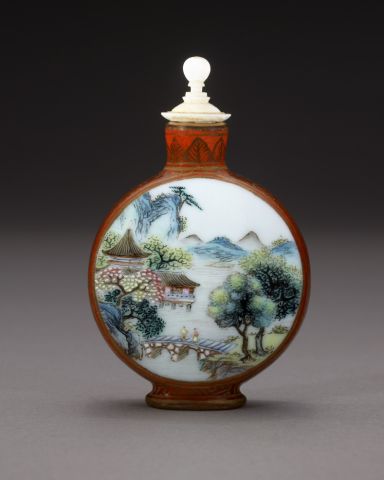
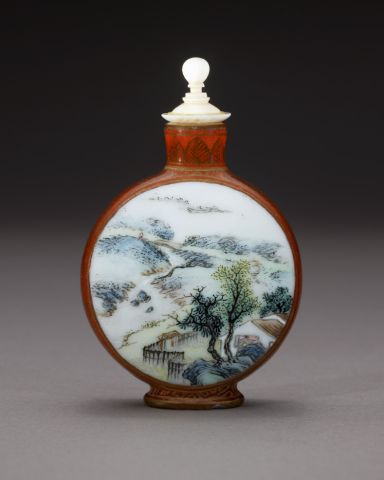
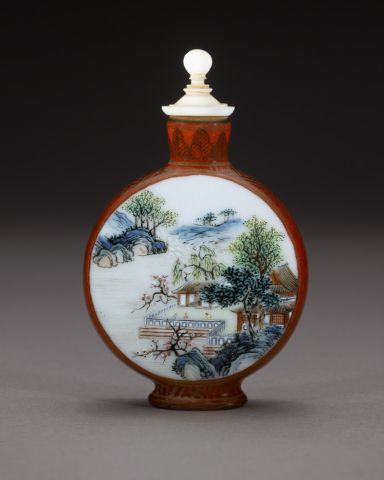
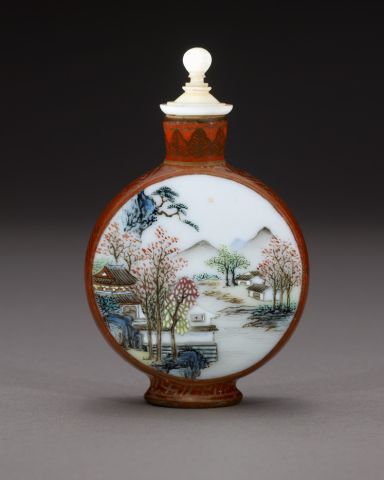
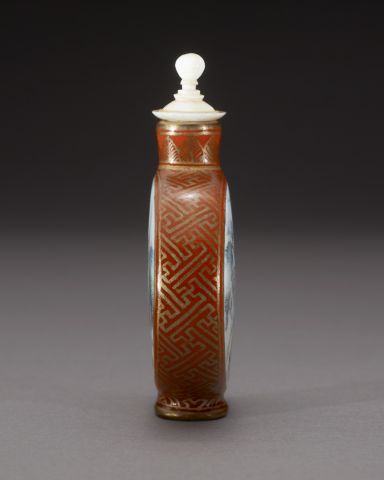
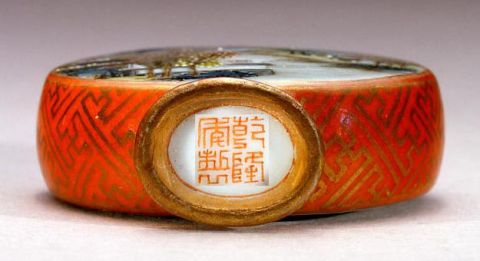
Bottle ID: 00345
ENAMELED FAMILLE ROSE, PAIR OF MOONFLASKS W/LANDSCAPE OF FOUR SEASONS
Date: 1742-1756
Height: 51 mm
A pair of hard paste porcelain snuff bottles, each of miniature moon flask form, with flattened sides, a slightly splayed neck with a rounded gilded mouth rim, the splayed foot with an indented oval base; decorated in famille rose and iron-red enamels and gilded, with traditional landscapes of the Four Seasons; the circular panels surrounded by iron-red enamel borders, gilded over the surface with a lattice pattern below an acanthus leaf border around the necks; the footrims gilded and the bases each with a four character Qianlong nianzhi mark in seal script and of the period.
The panels are enameled as follows:
Spring: With two figures crossing a stony bridge in a mountainous landscape scene with blossoming trees and pavilions nestled beside them overlooking the water.
Summer: With a similar scene with leafy flowering trees, a figure seated in a pavilion on the left bank, looking out over the water and across to buildings on the opposite bank.
Autumn: With a similar scene with leafy trees with a figure seated in a building on the right bank looking out over the river, a figure in the distance on the opposite side.
Winter: With a similar scene with prunus and pine trees with three figures standing on a terrace outside a building on the right bank.
Similar Examples:
Hall, Robert. Chinese Snuff Bottles VII, The Art of an Imperial Addiction, 1995, p. 8, no. 1.
Xia Gengqi, Zhang Rong. Masterpieces of Snuff Bottles in The Palace Museum, Beijing, 1995, p. 157, no. 160.
JICSBS, Autumn 2003, p. 8, figs. 3-a, b and c.
Provenance:
Clare Lawrence Ltd.
Sotheby's, New York, March 23, 1998, lot 79
Ma, Beijing
Exhibited:
Annual Convention ICSBS Toronto, October 2007
Published:
JICSBS, Autumn 1998, p. 24, fig. 2
These highly rare and superb pair of moon flask porcelain bottles can be attributed to the period of Tang Ying at the Imperial Kilns at Jingde Zhen. In 1726, in the third year of Yongzheng, Tang Ying became supervisor of the Imperial Factory at Jingde Zhen, a post he maintained for over a quarter of a century until he retired in 1756. The Palace Museum in Beijing houses a comparable example to this pair, of the same form, painted on one side with apricot flowers in the famille rose palette and on the reverse with an Imperial poem in clerical script followed by a Yuzhi mark (imperial composition) and two square seals Qian and Long. The Yuzhi mark indicates that the poem was one of the 43,000 composed by the Qianlong Emperor which were published in multiple volumes in the Leshan Tang ji and the Yuzhi shi quanji. The poem on this comparable bottle was written in 1733 when Qianlong was still a prince and not yet emperor as a colophon to an album of flowers by the court painter Zhou Yigui. The base marks of all three bottles are similar, being well written and in the form of four character seals painted in iron-red enamel on a transparent glazed base and enclosed along the inner edge of the footrim with an iron-red border. The mouth and footrims are in all cases gilded. Gilding of the foot and mouth of Imperial porcelain snuff bottles seems to be a general feature of all bottles made in the Qianlong period, regardless of how worn the gilding becomes. The thin oval border, however, is a very rare and early feature, and is not found on later Imperial porcelain bottles.
< Back to full list
 English
English 中文
中文